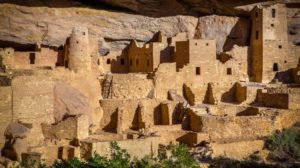HOPI LCR TRIAL WEEKLY REPORT : Week 3

Week 3: Trial Report Update of Little Colorado River – Adjudication Trial
Summary of Week 3 : September 24, 2018
- The United States, as trustee for the Hopi Tribe, finished its case-in-chief this week.
- Case in chief refers to the phase of a trial where the party with the burden of proof (Hopi) in the case presents its evidence. It is usually presented at the beginning of the trial.
- Hopi will present its case-in-chief on Monday, October 1
- 3 witnesses presented evidence to support the amount of surface water from Northern Washes that has historically been used for irrigated agriculture on the Hopi Reservation. This is what will establish quantification (amount of water to sustain Hopi when deciding how much % water rights will go to Hopi)
- Witnesses present were: Brent Cody (hyrdrologist), Eileen Camilli, expert in Indian water rights cases and testify estimates on number of acres that are used in farming and Tom Ley of Natural Resources Consulting Engineers (NCRE) – to present a projection model of an average year, the model gave 12,000-acre feet for diversion to crops; on the maximum year, the model gave 18,000-acre feet for diversion from the washes to the crops.
Key Note Item: This trial is on Hopi past and present water use. Tom Ley did not model how the Navajo Nation is taking water from above the Hopi Northern Reservation boundary. He assumed all the water from the North flowed onto the Hopi Reservation. How Navajo must let water through its Reservation to satisfy Hopi past use of water is not an issue for this trial, but is an issue reserved for the future. In addition, evidence presented by Eileen Camilli utilized arial photography from the 1950’s which shows inaccurate representation. Hopi will counter evidence presented by witnesses present on half of U.S. Government, Oct. 1, 2018
Week 3: Full Weekly Report
Source: Chairman Timothy Nuvangyaoma,Office of Hopi Tribe
The Hopi Little Colorado River water rights trial continued into its third week on September 24, 2018. This first of several trials is on Hopi past and present use of water on the 1882 and Moenkopi Reservations. The United States, as trustee for the Hopi Tribe, finished its case-in-chief this week.
As noted last week, the Court made a significant ruling that allows expert
reports to come into evidence with only brief testimony from the witness as to its conclusions, then allow longer cross examination and re-direct. Under this new procedure, the case is accelerated and United States finished its case-in-chief.
The United States finished its case with three witnesses who attempted to quantify in acre feet how much surface water from the Northern Washes has historically been used for irrigated agriculture on the Hopi Reservation. This is a monumental task, as the history of farming by the Hopi on the Mesas and in Moencopi goes back a millennium.
The first witness in this trilogy was Brent Cody, a hydrologist consultant for the government, who ran a USGS computer model that mirror the actual water flow through the Northern Washes from 1949 to 2004. His model provided data of how much water flowed down the washes to be available for crops each year.
The second witness, Eileen Camilli of Ebert and Associates, Albuquerque, New Mexico, testified this week. She works with the government in Indian water right cases to help estimate the number of acres that are used in farming. Based upon historical photos of the Hopi Reservation, primarily from the 1950’s, she testified that the largest number of acres in one year where wash water was used for irrigation, for range forage, or for agriculture from springs and Pasture Canyon, was 13,000 acres plus.
Hopi Tribe’s counsel criticized the United States’ model for relying primarily on aerial photos in the 1950’s. For example, water spreaders and dams constructed in the 1940’s flooded thousands of range acres for forage, but would not be on the aerial photos of the 1950’s. Moreover, in a prior United States claim which relied on all historical acreages shown on aerial photos, created from 1934 and other years up to the 1990’s, Ebert and Associates had found 39,000 acres of historical agriculture. The Hopi Tribe will argue they undercounted Hopi agricultural acreage.
The last government witness was Tom Ley from NCRE in Fort Collins, Colorado. NCRE, using the rainfall numbers from Cody, and the irrigated acreage numbers from Camilli, created and ran a program that modeled how much wash water from the Northern Washes would be diverted to Hopi farms and used on the crops. On an average year, the model gave 12,000-acre feet for diversion to crops; on the maximum year, the model gave 18,000-acre feet for diversion from the washes to the crops.
This trial is on Hopi past and present water use. Tom Ley did not model how the Navajo Nation is taking water from above the Hopi Northern Reservation boundary. He assumed all the water from the North flowed onto the Hopi Reservation. How Navajo must let water through its Reservation to satisfy Hopi past use of water is not an issue for this trial, but is an issue reserved for the future.
After Tom Ley’s testimony, the United States rested its case-in-chief. The Hopi Tribe begins its case-in-chief on Monday, October 1. Where the United States presented testimony exclusively by expert witnesses, the Hopi Tribe will present both Hopi fact witnesses, department heads and expert witnesses.
The Hopi lawyers are again encouraging Hopi Tribal members to come down and be present at the trial. After all, this is the Hopi future on trial!





